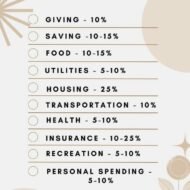Posted by Managementguru in Financial Management, How To, Personal Finance
on Aug 7th, 2022 | 0 comments

A small intro to personal finance is inevitable before we explain the 50/30/20 budget rule. Why Is Personal Finance Important? Learning Personal Finance not only helps you to manage your day-to-day financial needs but also aids in planning your financial future. The sooner you get a hold on personal finance, the better your long-term financial prospects will be for things like investing or planning for retirement. What are the 5 main components of personal finance? SavingInvestingFinancial protectionTax SavingRetirement planning The Pathway to Financial Freedom – The 5 Golden Rules of Money Let us understand what the financial experts say about how to handle money when it comes to your pocket. Payday is not only mayday but also hayday. You have to streamline your income in order to lead a hassle free and peaceful life. Rule # 1: Spend Less Than You Earn or Earn More Than You Spend Rule # 2: Create an Emergency Fund Rule #3: Save or Invest the Rest Rule #4: Capitalize on Your Skills & Create a Side Endeavor Rule #5: Own Income Generating Assets That Create Passive Income Streams The ideas listed above are truly practical in nature and works out 100% of the time. Passive income is equally important as this income stream might become your mainstream income during a dire need. We have compiled an amazing Budget Planner for your ready reference. Download and Enjoy. 👇 Tell us if you found it useful. Simple-Monthly-Budget-PlannerDownload What is the 50/30/20 Rule of Budgeting? Given below is the thumb rule for budgeting and this method is good for beginners or those who suck with money. This cheatsheet will teach you how to “Live within your means.” The beauty of 50/30/20 budget is in its simplicity. All the income is broken up into three spending buckets. 50% for the needs, 30% for wants and 20% for savings and debt. The Split 50% Needs Health life, disability and other insuranceCar insurance, maintenance and gasMedical bills and prescriptionsUtilities phone and internetPublic transportationDaycare and tuitionMortgage/rentGroceries 7 Ways to Increase Your Income! #reels 30% Wants GiftsTravelCable TVEating outCharitable donationsMakeup and hair productsHome decor and furnitureClothes, shoes and accessoriesMovie, sports and concert ticketsStreaming services and other subscriptions Signs You’re A Lot Better With Money Than You Think! #reels 20% Savings Retirement savingsPersoanl loan paymentsShort term savings goalsEducation fund What are some practical budgeting guidelines to follow? Read on to find out what budget percentages popular financial guru Dave Ramsey recommends. Here’s a breakdown of each category, based on Dave Ramsey’s advice: Giving — Ramsey recommends giving 10% of your monthly income to worthy causes.Saving — Saving 10% of your income for retirement, which ideally is within a 401(k) or IRA.Food — Includes both grocery shopping and eating out.Utilities — Cell phone, cable, internet, gas, and electricity.Housing costs — Rent or mortgage payment, along with property tax, home or renters insurance, home maintenance, HOA fees, and PMI.Transportation — Any and all transportation costs, including public transportation, car insurance, oil changes, car payment, gas, DMV fees, and parking.Health — Medical and health care bills (not including health insurance premiums) such as co-pays for doctor visits, prescriptions, and dental care.Insurance — Life insurance, health insurance, and disability insurance. Auto insurance and home insurance is placed within transportation and housing categories. Recreation — This is your fun money. Any lifestyle expenses, such as gym memberships or kids’ activities, as well as entertainment expenses like Netflix, Hulu, sporting events, concert tickets, babysitters, and travel.Personal spending — Personal care, haircuts, Amazon purchases, clothes, shoes, home furnishings, home decor, etc.Miscellaneous — The “stuff you forgot to budget for” category. The Complete Personal Finance Course: Save, Protect, Make...


